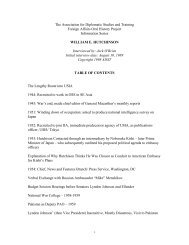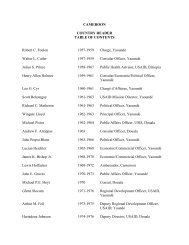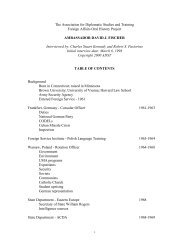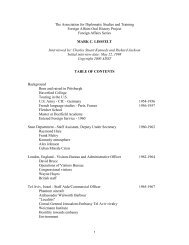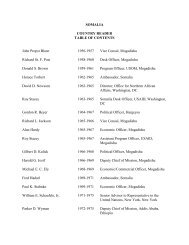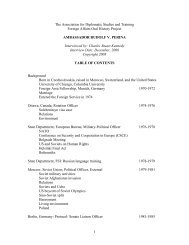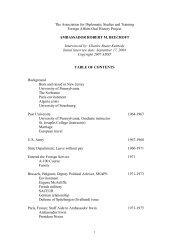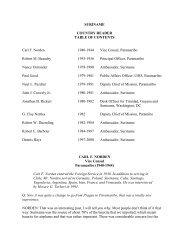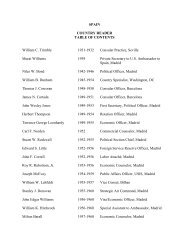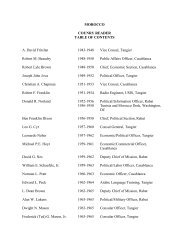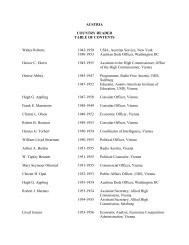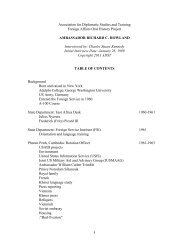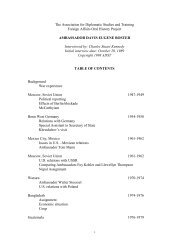1 The Association for Diplomatic Studies and Training Foreign ...
1 The Association for Diplomatic Studies and Training Foreign ...
1 The Association for Diplomatic Studies and Training Foreign ...
You also want an ePaper? Increase the reach of your titles
YUMPU automatically turns print PDFs into web optimized ePapers that Google loves.
MILLER: <strong>The</strong> hierarchy of power was at the head was the shah, the shah made the claim,<br />
<strong>and</strong> of course, his entourage <strong>and</strong> many throughout the country believed, that Iran was the<br />
shah, that he owned the country, but in the vibrant urban life of cities like Isfahan <strong>and</strong><br />
Shiraz <strong>and</strong> Tabriz this dominance was contested by those of great wealth <strong>and</strong> long held<br />
social position. <strong>The</strong>y thought they also had a piece of the country to which they had<br />
claim. <strong>The</strong> shah needed them as well to stay in power. That vitiated absolute power to<br />
some extent. <strong>The</strong> clergy were always split on the question of loyalty to the shah as the<br />
“Render unto Caesar…” was a reality <strong>and</strong> the spiritual life didn’t belong to the shah, he<br />
had to belong to the spiritual life as a kind of defender, or as more accurate, in his case,<br />
persecutor of the faith.<br />
<strong>The</strong>re was a well known hierarchal list of power of so called “1,000 Families” who were<br />
the great l<strong>and</strong> owners of Iran. Many on the list were from the previous times – Qajars,<br />
Safavids or the great bazaar merchants, Isfahan of course having the most extensive <strong>and</strong><br />
complicated bazaar. <strong>The</strong>se bazaar families were extraordinarily important. <strong>The</strong>y were the<br />
financial support necessary <strong>for</strong> the regime. <strong>The</strong>y were also the support <strong>for</strong> the clerical<br />
establishment through charitable contributions on the vaqf, the inheritance, <strong>and</strong> they were<br />
political powers in their own right. Of course, commercial activity was crucial to the<br />
society as a whole.<br />
Those were the worthies. Isfahan was a wonderful place <strong>for</strong> anyone interested in learning<br />
about the complexities <strong>and</strong> richness of Iran, particularly one from the United States. A<br />
diplomat at that time was welcome. I learned about Iranian society in ways that were<br />
much superior to the method imposed upon embedded journalists, <strong>for</strong> example, now.<br />
Q: When you got outside – talk about consulate trips, too. When you got outside going<br />
into your area, which is quite an extensive one, how did you feel about what you were<br />
picking from this?<br />
MILLER: It was a huge consulate district. It extended to the Afghan border on the east,<br />
included the religious city of Qom in the north, it went to the Iraqi border on the west, the<br />
Persian Gulf to the south, <strong>and</strong> everything in between. It was a vast piece of territory, with<br />
huge variations of kinds of life.<br />
Typically, I would spend at least a week or two every month on the road. <strong>The</strong> trips were<br />
primarily by jeep, because the cities <strong>and</strong> the settlements <strong>and</strong> villages were great distances<br />
between each other. <strong>The</strong> distances between settlements were due to the largely desert<br />
character of the plateau. Villages existed where there was water. <strong>The</strong> roads were very<br />
difficult; at best they were corrugated dirt roads. Travel anywhere meant adventure.<br />
So I would have our great driver, Khachik, <strong>and</strong> one of the Oriental secretaries would<br />
often go along. A good example would be a trip to Yazd, which is to the east of Isfahan<br />
<strong>and</strong> over a range of mountains to the edge of the desert, Dasht-e Lut. <strong>The</strong> trip to Yazd<br />
would take about five or six hours. Yazd, itself had an extensive bazaar, several important<br />
43




